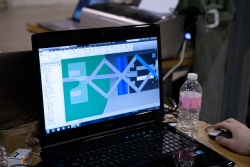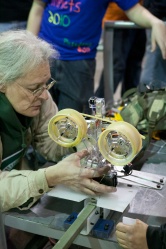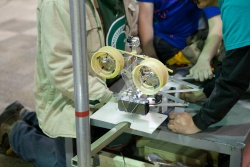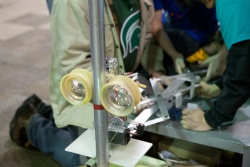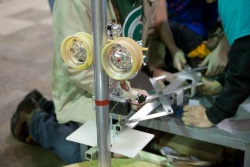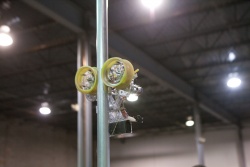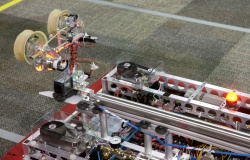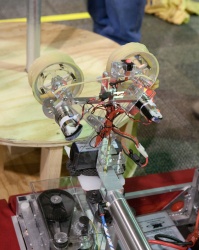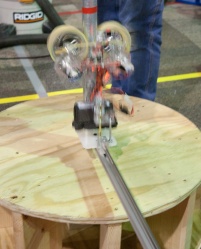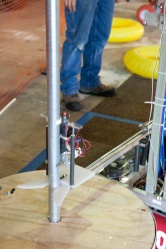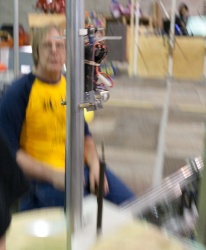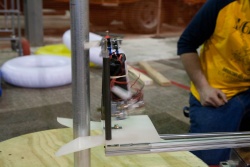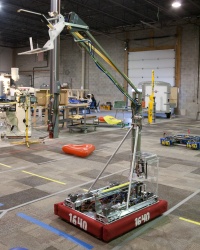Difference between revisions of "DEWBOT VII Minibot Deployment"
(question (and spelling)) |
m (not sure how that happened) |
||
| Line 51: | Line 51: | ||
::*The minibot motors are activated by deployment (by pulling a "hand grenade" pin); not by pole contact | ::*The minibot motors are activated by deployment (by pulling a "hand grenade" pin); not by pole contact | ||
::*The minibot is protected by a polycarbonate hangar top & outboard and by the arm columns inboard | ::*The minibot is protected by a polycarbonate hangar top & outboard and by the arm columns inboard | ||
| − | + | ::*An ad-hoc brace added to stiffen the deployment system at [[DEWBOT VII Finger Lakes Regional | Rochester]], which interfered with lifting the robot, is eliminated. | |
:Extensive testing on ''deux'' indicates high deployment reliability and rapid alignment. If alignment misses, the robot can drive the minibot onto the tower. ''(Have they actually practiced this? - Siri)'' | :Extensive testing on ''deux'' indicates high deployment reliability and rapid alignment. If alignment misses, the robot can drive the minibot onto the tower. ''(Have they actually practiced this? - Siri)'' | ||
Revision as of 04:30, 30 March 2011
Analysis of Minibot deployment considerations and concepts. Updated 23 Jan 2011, Siri.
Scissors ( V-Bot)
- Initial concept for deploying the Minibot and applied to the V-bot.
- The system was to deploy transverse (to the side) and included an alignment bar with limit switches to help align the deployment system (and robot) with the tower. The alignment bar further served as a mechanical support for the scissors.
- Assembled for testing only on 20-February. Manual deployment tests indicated that this deployment method would not be reliable. Additional issues with off-axis deployment of the one or two 3/4" bore, 5" stroke pneumatic cylinders were unresolved.
Bident Forwards ( V-Bot)
On 20-Feb, the launch platform of the Scissors deployment system was adapted to a direct pneumatic deployment. A 1½" bore, 24" stroke pneumatic cylinder was used to power this deployment. In parallel, an 80/20 1010 profile deployment arm supported by 80/20 roller guides carried the launch platform. Standoffs between the roller guides and chassis frame put the deployment at the correct height.
This system was named Bident due to the forked launch platform at the end of a deployment arm.
Due to the overall length of the deployment system, it had to be reoriented to be parallel to the robot's long axis. It was positioned off-axis to avoid interference with the arm and claw; directly over the left inner longitudinal.
A camera aiming forwards and down was to be used to assist in aligning the robot with the tower and to guide the operator in tube pickup. At the Finger Lakes Regional, the camera system did not function.
In testing prior to bagging, this deployment system worked well, although the small opening of the Bident required very accurate alignment with the tower.
At the Finger Lakes Regional, we failed to successfully launch a Minibot. This was primarily due to premature activation of the V-Bot brought on by normal game vibrations, bouncing and bumping.
In addition, the front left corner of DEWBOT VII is not the safest place to live during a competition, and the V-bot was damaged on several occasions.
Bident Aft (Fanger)
- Experience at Rochester how exposed the minibot was to game damage on the robot's front left corner. Reversing the deployment placed the minibot at the rear left corner. In this new position, the arm columns provide some protection while also offering a practical anchor for a protective Minibot Hangar.
- While identical in principle to the previous deployment system, significant changes/improvements were incorporated into the reverse bident. These are:
- Increased standoff elevation from 4.25" to 5.75"
- A wider Bident is employed, reducing the level of alignment precision needed
- The camera is mounted on the deployment axis; just below the launch platform
- The Launch platform is adapted to our new minibot, Fanger
- The minibot motors are activated by deployment (by pulling a "hand grenade" pin); not by pole contact
- The minibot is protected by a polycarbonate hangar top & outboard and by the arm columns inboard
- An ad-hoc brace added to stiffen the deployment system at Rochester, which interfered with lifting the robot, is eliminated.
- Extensive testing on deux indicates high deployment reliability and rapid alignment. If alignment misses, the robot can drive the minibot onto the tower. (Have they actually practiced this? - Siri)
- DB7 baby on board 110319 csm.jpg
Post-FLR deployment (in development)
